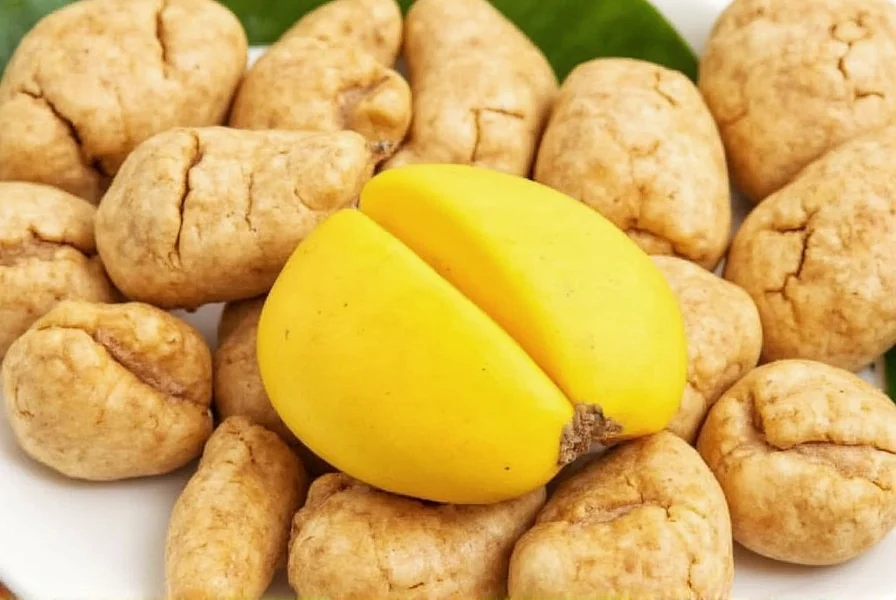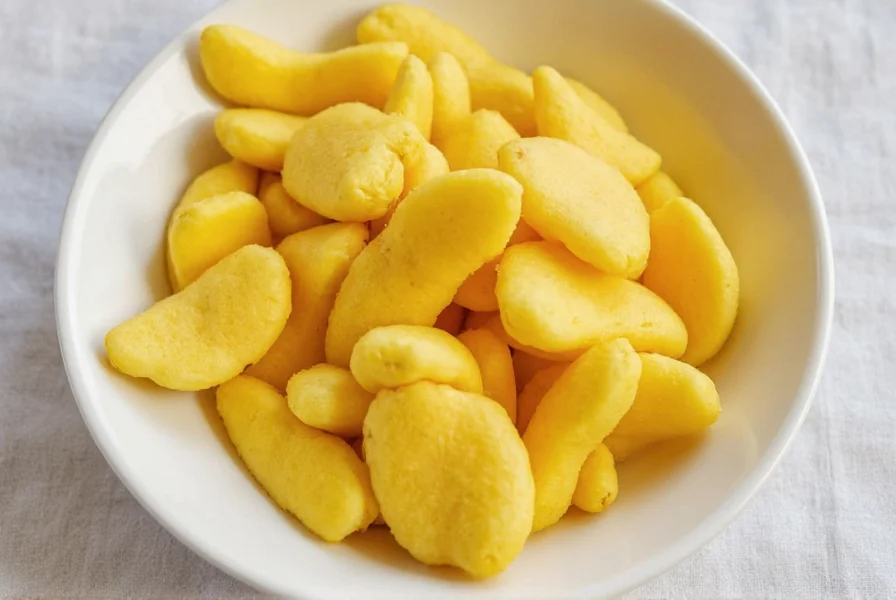Mango ginger often causes confusion due to its misleading name. Many searchers mistakenly believe it's a cross between mango fruit and ginger root. In reality, Curcuma amada belongs to the same botanical family as turmeric (Curcuma longa) and shares structural similarities with ginger, though it delivers a completely different sensory experience. This aromatic rhizome has been cultivated for centuries across South Asia, where it features prominently in regional cuisines and traditional healing practices.
Botanical Characteristics of Mango Ginger
Scientifically classified as Curcuma amada, mango ginger grows as a herbaceous perennial reaching 60-90 cm in height. Its distinctive features include:
| Characteristic | Description |
|---|---|
| Rhizome Appearance | Resembles ginger with brown outer skin, but reveals pale yellow flesh when cut |
| Aroma Profile | Citrus-pine fragrance with subtle mango undertones and mild ginger notes |
| Taste | Tangy, slightly sour, with refreshing citrus notes and minimal heat |
| Plant Features | Large green leaves, purple-tinged stem, yellow flowers with purple markings |
The plant thrives in tropical and subtropical climates with well-drained soil and partial shade. Unlike common ginger which develops significant heat, mango ginger maintains a delicate balance of flavors that makes it particularly valuable in culinary applications where intense spiciness would be undesirable.

Culinary Applications of Curcuma Amada
Chefs and home cooks value mango ginger for its ability to add complex flavor without overwhelming heat. In Indian cuisine, particularly in the eastern states of Odisha and West Bengal, it features prominently in:
- Pickles and preserves - Its firm texture holds up well during preservation
- Chutneys and relishes - Provides bright acidity that complements spicy dishes
- Seafood preparations - Pairs exceptionally well with fish and shellfish
- Salad dressings - Offers a refreshing alternative to conventional ginger
- Desserts and beverages - Used in some traditional sweet preparations
When substituting mango ginger in recipes, consider that its flavor profile differs significantly from regular ginger. For mango ginger vs regular ginger applications, use approximately 25% more mango ginger to achieve comparable flavor impact, as it lacks the pronounced heat of Zingiber officinale. Fresh rhizomes work best, though dried powder (less common) can substitute in certain applications.
Traditional Medicinal Uses and Modern Research
Ayurvedic medicine has utilized mango ginger for centuries to address digestive issues, respiratory conditions, and inflammation. Traditional preparations include:
- Raw consumption for digestive support
- Infusions for respiratory relief
- Topical applications for skin conditions
- Combination with other herbs for holistic treatments
Modern scientific research on Curcuma amada uses remains limited compared to turmeric or common ginger, but preliminary studies suggest potential benefits:
- Antioxidant properties comparable to other Curcuma species
- Possible anti-inflammatory effects
- Antimicrobial activity against certain pathogens
- Preliminary evidence of digestive benefits
Researchers note that while promising, current evidence for is mango ginger good for health claims remains preliminary. Most health benefits documented in traditional medicine haven't undergone rigorous clinical validation. As with any botanical, consult healthcare providers before using mango ginger for therapeutic purposes, especially if taking medications or managing health conditions.
Cultivating Mango Ginger at Home
Gardeners interested in growing mango ginger plant care should note these essential requirements:
- Climate: Thrives in USDA zones 8-11; requires warm temperatures (70-90°F) and high humidity
- Soil: Well-draining loam with organic matter; pH 6.0-7.5
- Light: Partial shade (2-4 hours of morning sun ideal)
- Watering: Consistent moisture without waterlogging
- Planting: Set rhizome sections 2 inches deep, 8-12 inches apart
Growth typically begins within 3-4 weeks, with mature plants reaching harvest readiness in 8-10 months. Unlike common ginger which becomes fibrous when mature, mango ginger maintains its desirable texture throughout its growth cycle. Harvest by carefully digging around the plant to remove rhizomes while leaving some in the ground for continued growth.
Finding and Substituting Mango Ginger
Locating fresh where to buy mango ginger can prove challenging outside South Asian communities. Your best options include:
- Specialty Indian or Southeast Asian grocery stores
- Farmers markets in regions with significant South Asian populations
- Online specialty spice retailers (often sold dried or powdered)
- Local growers specializing in exotic botanicals
When fresh mango ginger proves unavailable, consider these substitution strategies for mango ginger substitute needs:
- For pickling: Equal parts fresh ginger plus a squeeze of lime juice
- For chutneys: Young ginger with a touch of mango puree
- For raw applications: Thinly sliced young ginger soaked in citrus juice
- For beverages: Ginger tea with added lemon grass and citrus zest
Remember that no substitute perfectly replicates mango ginger's unique flavor profile, but these combinations can approximate its distinctive characteristics in various applications.
Common Misconceptions Clarified
Several persistent myths surround mango ginger that deserve clarification:
- Misconception: It's a hybrid of mango and ginger plants
Reality: It's a distinct species (Curcuma amada) unrelated to mango trees - Misconception: It tastes strongly of mango
Reality: Offers subtle mango-like notes rather than pronounced mango flavor - Misconception: It's interchangeable with common ginger
Reality: Different flavor profiles require recipe adjustments when substituting - Misconception: It's widely available globally
Reality: Primarily found in South Asian markets and specialty stores
Understanding these distinctions helps cooks and consumers make informed decisions when encountering this unique botanical. The name mango ginger refers to its aromatic qualities rather than any botanical relationship to either mango or ginger plants.
Frequently Asked Questions
Is mango ginger actually related to mangoes?
No, mango ginger (Curcuma amada) has no botanical relationship to mango trees (Mangifera indica). The name refers to its subtle mango-like aroma rather than any genetic connection. It belongs to the same Zingiberaceae family as ginger and turmeric, but is a distinct species unrelated to actual mango fruit.
Can I substitute regular ginger for mango ginger in recipes?
You can substitute regular ginger for mango ginger, but with important adjustments. Since mango ginger has minimal heat and distinctive citrus notes, use about 25% less regular ginger and add citrus juice (lemon or lime) to approximate the flavor profile. For pickling applications, young ginger works better than mature rhizomes.
Where can I find fresh mango ginger outside India?
Fresh mango ginger is most reliably found in specialty Indian or Southeast Asian grocery stores, particularly in areas with significant South Asian populations. Some online specialty spice retailers offer fresh or dried mango ginger, though availability varies by season. In Western countries, it's uncommon in mainstream supermarkets but may appear in farmers markets during summer months in regions with appropriate growing conditions.
Does mango ginger have the same health benefits as regular ginger?
Mango ginger shares some properties with regular ginger due to their botanical relationship, but research on its specific health benefits remains limited. While traditional medicine attributes similar digestive and anti-inflammatory properties to both, scientific validation for mango ginger specifically is less established than for Zingiber officinale. Current studies suggest antioxidant and antimicrobial properties, but more research is needed to confirm therapeutic applications.
How should I store fresh mango ginger to maximize shelf life?
Store fresh mango ginger rhizomes in a paper bag in the refrigerator's vegetable drawer, where they'll stay fresh for 2-3 weeks. For longer storage, peel and slice the rhizome, then freeze in an airtight container for up to 6 months. Drying and powdering is another preservation method, though this diminishes some of the distinctive fresh aroma that makes mango ginger valuable in culinary applications.











 浙公网安备
33010002000092号
浙公网安备
33010002000092号 浙B2-20120091-4
浙B2-20120091-4